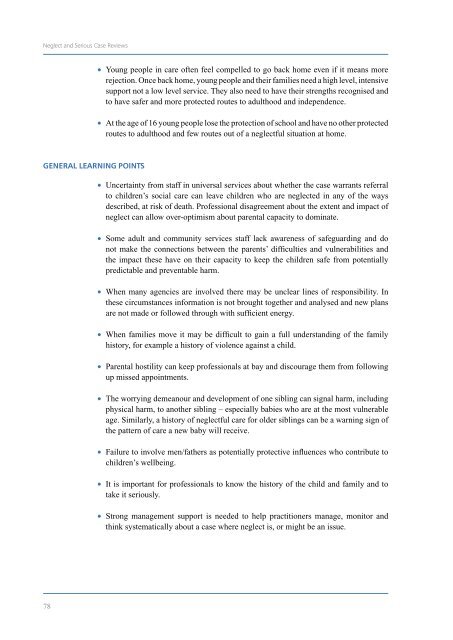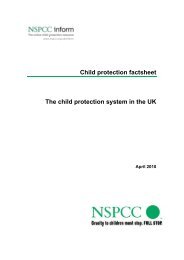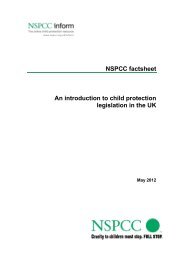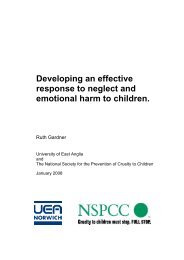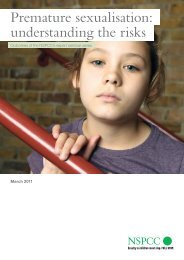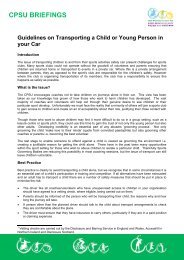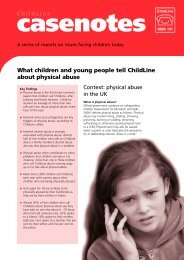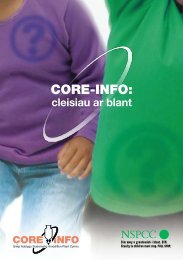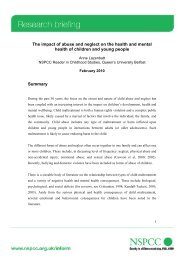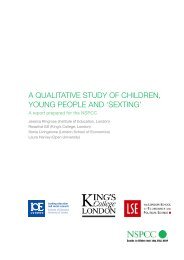Neglect and serious case reviews (PDF, 735KB) - nspcc
Neglect and serious case reviews (PDF, 735KB) - nspcc
Neglect and serious case reviews (PDF, 735KB) - nspcc
Create successful ePaper yourself
Turn your PDF publications into a flip-book with our unique Google optimized e-Paper software.
<strong>Neglect</strong> <strong>and</strong> Serious Case Reviews<br />
geNeral learNiNg poiNtS<br />
78<br />
• Young people in care often feel compelled to go back home even if it means more<br />
rejection. Once back home, young people <strong>and</strong> their families need a high level, intensive<br />
support not a low level service. They also need to have their strengths recognised <strong>and</strong><br />
to have safer <strong>and</strong> more protected routes to adulthood <strong>and</strong> independence.<br />
• At the age of 16 young people lose the protection of school <strong>and</strong> have no other protected<br />
routes to adulthood <strong>and</strong> few routes out of a neglectful situation at home.<br />
• Uncertainty from staff in universal services about whether the <strong>case</strong> warrants referral<br />
to children’s social care can leave children who are neglected in any of the ways<br />
described, at risk of death. Professional disagreement about the extent <strong>and</strong> impact of<br />
neglect can allow over-optimism about parental capacity to dominate.<br />
• Some adult <strong>and</strong> community services staff lack awareness of safeguarding <strong>and</strong> do<br />
not make the connections between the parents’ difficulties <strong>and</strong> vulnerabilities <strong>and</strong><br />
the impact these have on their capacity to keep the children safe from potentially<br />
predictable <strong>and</strong> preventable harm.<br />
• When many agencies are involved there may be unclear lines of responsibility. In<br />
these circumstances information is not brought together <strong>and</strong> analysed <strong>and</strong> new plans<br />
are not made or followed through with sufficient energy.<br />
• When families move it may be difficult to gain a full underst<strong>and</strong>ing of the family<br />
history, for example a history of violence against a child.<br />
• Parental hostility can keep professionals at bay <strong>and</strong> discourage them from following<br />
up missed appointments.<br />
• The worrying demeanour <strong>and</strong> development of one sibling can signal harm, including<br />
physical harm, to another sibling – especially babies who are at the most vulnerable<br />
age. Similarly, a history of neglectful care for older siblings can be a warning sign of<br />
the pattern of care a new baby will receive.<br />
• Failure to involve men/fathers as potentially protective influences who contribute to<br />
children’s wellbeing.<br />
• It is important for professionals to know the history of the child <strong>and</strong> family <strong>and</strong> to<br />
take it <strong>serious</strong>ly.<br />
• Strong management support is needed to help practitioners manage, monitor <strong>and</strong><br />
think systematically about a <strong>case</strong> where neglect is, or might be an issue.


